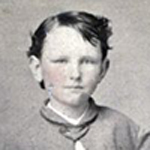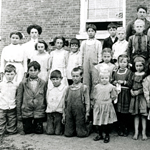THE CULTURE OF CHILDHOOD IN 19TH-CENTURY AMERICA
 |
 |
 |
 |
Introduction
Many factors shaped the lives of children in nineteenth-century Vermont. Some children lived on farms and were important contributors to the farm economy. Others who lived in working-class or immigrant households earned wages as servants or as workers in the factories that developed along the banks of Vermont’s rivers and creeks. Middle-class children attended church and school, played with homemade and store-bought toys, and were the focus of careful childrearing practices.
All children had access to basic public education in nineteenth-century Vermont, although a family’s occupational and financial circumstances sometimes limited a student’s attendance. As early as 1777, the Vermont state constitution mandated that each town maintain a common school and each county a grammar school. Early Vermont schools were hardly comfortable by today’s standards. The first common schools were one-room buildings with rough benches for students, a teacher’s desk, and a woodstove to protect against the cold. Prior to the 1860s, teachers were generally poorly paid, had little formal training, and were often teenagers themselves. Books and other instructional materials were limited. The conditions of Vermont schools improved considerably in the latter half of the nineteenth century as the teaching profession became more professionalized and advances in print technology led to a wider range of textbooks and other teaching materials.
Just as education underwent considerable change in the nineteenth century, so did many other aspects of children’s lives. Advances in commerce, transportation infrastructure, and manufacturing led to an increase in commercial goods for children, including factory-made clothing, toys, and juvenile literature. The advent and subsequent popularization of photography created a rich visual record of children’s lives. Beginning with formal daguerrotypes in the mid-nineteenth century and ending with snapshots of family vacations, photographs provide vivid documentary evidence of the vast transformation in the conceptualization and culture of childhood in the nineteenth century.
While the experience of a child born in 1890 differed vastly from that of her great-grandmother born in 1810, some elements remained more or less constant: race, class, and residential location continued to differentiate one child’s experience from another’s. Perhaps even more noticeably, a child’s gender defined his or her experience throughout the nineteenth century. Just as the dominant culture of nineteenth-century America was divided into male and female spheres, so too were boyhood and girlhood profoundly different from each other.
The pages in this site afford you the opportunity to explore the culture of childhood in nineteenth-century America, with a particular emphasis on the experiences of Vermont children.